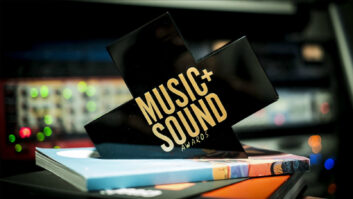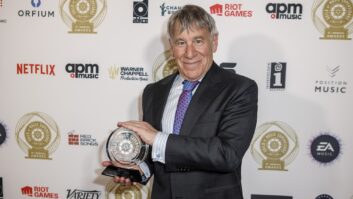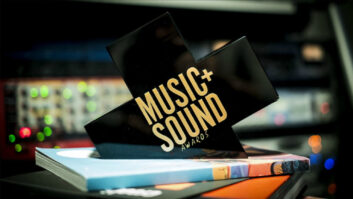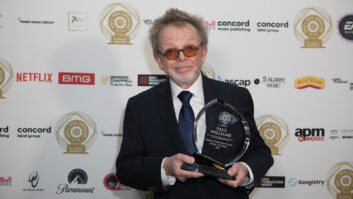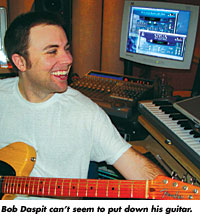
We’ve moved from MIDI to audio files, from 22kHz mono playback to44.1 stereo, and from repetitive bursts of loops to full scoring andinteractive transitions — in key. Files once sent to programmerson DAT are now delivered as sessions or .AIFF or .WAV files. We’ve evenreached the point where songs are making their way into the gamingexperience, breaking new artists and resuscitating older, genre-basedstars (see “Licensing,” page 66).
Any way you look at it, music has upped the profile of sound inthe game experience. While it’s easy, and not always accurate, to saythat creation of score for video games rivals that of a feature film,the two mediums do share the demands that a composer must work in grandthemes and short snippets. Here we profile twomusicians-turned-composers — one a guitar slinger, one akeyboardist and trumpeter — and find out how they entered theworld of video games.
BOB DASPIT
Guitar Ace Turned Game Composer
By Bryan Reesman
After beginning his musical career as a Sunset Strip glam-rocker,composer and musician Bob Daspit has evolved during the course of 17years to become a session player for film scores, a record producer andvideo game composer, becoming known for soundtracks to such games asSpy Hunter, Terminator: Dawn of Fate and the newMission:Impossible — Operation Surma.
In the mid-’80s, Daspit fronted an L.A. hair band, and hissix-string playing scorched such clubs as The Roxy and Whisky A-Go-Go.After the group broke up, he went on to UCLA and graduated in 1990 witha B.S. in Philosophy. Soon after, on the recommendation of Eric Persing(now head of Spectrasonics), he was hired by Roland R&D.“This was when the S-770 was coming out,” he recalls,“so I was brought in to work on their sample libraries. I waswith them for the next five years.” He recalls working with an SE20 when Macs were smaller. He also remembers how long it took to loop asample.
Musicians who knew sampling were in high demand with film compsersat the time, and Daspit landed a gig with renowned Hollywood composerHans Zimmer. It would last for a decade, and he would occasionally dosession work as a guitarist, keyboardist or sampler for most of theprominent Los Angeles — based film composers. His first movie wasToys, to which he contributed guitar work. He has sinceperformed on more than 65 movie soundtracks.
While session work on films kept him busy, it did not offer much inthe way of career advancement. When an old business associate hookedDaspit up with a gig scoring the Duck Dodgers video game(Paradigm Entertainment, for the original Playstation), it was awelcome and refreshing challenge.
“I not only had to write the music, but I had to create thesound set for it,” Daspit recalls. “They used to hire abunch of different people: One guy would do the music, another guywould encode the sound set and another guy would integrate that intothe game. They liked me because I could do the sound set [and themusic]. I had to take a full orchestra and cram it down to[approximately] 2 MB. Then the score was played back via MIDI. As faras interactivity, there was a lot more control over what could be done,but the sound was horrible. It’s amazing how far things have come sincethen. The way that games are scored now, it’s basically just withaudio. You do a full piece of music as you would for a film and theyjust place it in there. That’s it. There’s not a lot of control. That’sthe trade off, but I wouldn’t go back. It just sounds better thisway.”
Since scoring Duck Dodgers, Daspit has gone on to do severalmore games for Paradigm, which is now part of Atari. All three ofDaspit’s recent forays are for titles linked to famous franchises:Spy Hunter, which incorporates Henry Mancini’s famous“Peter Gunn Theme”; Terminator: Dawn of Fate; andthe new Mission:Impossible — Operation Surma, with itsinstantly recognizable theme.
“Mission: Impossible was great because I really lovethat theme,” Daspit acknowledges. “It’s pretty involved andI can sink my teeth into it. You’ve probably heard the Limp Bizkitversion and the U2 version and Danny Elfman’s version. I listened toall the versions, and I’ve got the original. Those guys had all kindsof resources, and I’m trying to do it on a laptop, so I try to dolittle rhythmic tricks or use the melody in a different way to dosomething fresh with it.” Listening to the composer’s work onM:I — OS, it is obvious he tried many differentapproaches, from ambient atmospheres to heavy metal mayhem.
After years in Tinseltown, Daspit and his wife relocated to NorthernCalifornia, where he constructed a home studio by converting half ofhis garage to a 10×13-foot control room with an adjoining4×6-foot vocal booth. It’s a modest setup used to maximum effect,and thanks to the Internet, he can work where he wants.
“Right now, I have a three-computer setup,” explainsDaspit. “I have a Pro Tools setup, which I mainly use on myrecord projects or if I need to record live instruments for videogames. I have a PC, which is pretty much dedicated for Ableton Live andI use it as a loop machine. Then my main rig is my Titanium G4 runningLogic. That’s really where I do the bulk of my work for the videogames. It’s kind of nice, because I can pull it in or out of thestudio. I can work on it literally anywhere.”
Daspit runs his Pro Tools|Mix 3 system on a G4/867 running OS 9.2.2.His hardware interfaces include an ADAT Bridge and an 888|24. He runshis Ableton Live rig on an HP Pentium 4 1.8GHz PC running Windows XPHome with RME Digiface. His Logic rig is on a Titanium G4/1 GHz runningboth OS 10.2.6 and OS 10.3, with a MOTU 896 audio interface clocked viaa Rosendahl Nanosync. The 896 and Digiface feed the Pro Tools rig viaLightpipe to the ADAT Bridge. His mic preamps, compressors, the 888|24and headphone feed all appear on a TT patchbay.
“When composing for video games, I almost exclusively use justthe Logic rig, usually just the laptop ‘untethered’ fromthe rest of the setup,” Daspit remarks. He uses Logic AudioPlatinum 6 as his sequencer, and his plug-ins are Emagic’s EXS-24, andStylus, Atmosphere and Trilogy from Spectrasonics. “In fact, Iscored all of Mission:Impossible with just these fourplug-ins.”
Although he uses samplers and sample playback to create the majorityof his scores, Daspit does not use many synthesizers. In fact, hecurrently doesn’t own any synths. “I used to have racks and racksof gear back when I was with Roland,” he remarks. “I hadall the products I worked on, from the JD-800 all the way through theJV-1080. Because I’m a guitar player too, I wanted to make a consciouseffort to keep my scores as acoustic as possible. So I try to stick tousing samplers and sample playback plug-ins, and anything else that Ido I’ll go to a studio or I’ll record something here and get humanbeings to play on top.”
The composer records his guitars in his home studio. He has a goodselection of amps — including various Fenders and a Dr. Z Route66 that he really likes — and his vocal booth is just big enoughto place a cabinet. He also owns a fair collection of guitars,including Les Pauls, Stratocasters and Telecasters, although he sayshe’s playing a lot of acoustic these days.
He observes that his best vocal mic is the Neumann M148, but hetends to favor the Brauner VM-1. He also owns RØDE NT2s, NeumannKM194s and Shure 57s, and he loves the Royer Labs SF-12 stereo ribbonmic: “That thing is just amazing,” he declares. “Ihaven’t heard it sound bad on anything.” Additionally, he ownsManley mic preamps, a Vox Box and a Variable-MU compressor.
Daspit mixes in Pro Tools with a HUI controller, while he has LogicConrol for his Logic rig. “Oftentimes, I don’t even have to takeit to Pro Tools,” he says. “I’ll just listen straight outof Logic. I have a MOTU 896 audio interface. A lot of times, I’ll justbe monitoring two channels out of my laptop, and that’ll be thefinished product.
“One interesting thing that I do is to use the same D/Aconverters for all of my gear,” Daspit reveals. “TheDigiface, MOTU and 888 analog outputs all sound vastly different, so Ifeed a pair of Lucid D/A 9624s digitally from each of the three audiointerfaces and only listen to the analog outputs of the Lucidconverters. That way, my D/A conversion is consistent, and I can reallytell what I’m listening to from rig to rig.”
In spite of all this technology at his fingertips, Daspit willcontinue to reduce the size of his digital arsenal. He says it feelsgreat to own less stuff. “Before the next video game, I’llprobably sell as much of this stuff as I can and probably get a G5 andcall it a day,” he divulges. “I don’t even think I’ll beusing the Pro Tools rig as much for the next game. I’ve just heard goodthings about people being able to record audio into the G5 with prettylow latency, and that’s finally starting to come together.”
Beyond video games, another new avenue opened up for Daspit when hewas asked to engineer and mix Sammy Hagar’s solo release, Ten13, in 2000. He landed the gig after being recommended by Hagar’sson (with whom he had written and recorded music previously) andproviding a sample mix of one of the songs. Since then, Daspitproduced, engineered and mixed Hagar’s Not 4 Sale and producedand mixed his concert release Live — Hallelujah.Additionally, he mixed and mastered Songs of Alan Broadbent byjazz artist Ron Berman.

TIM LARKIN
Out of the Myst Comes Uru
By Blair Jackson
One of the most ambitious and admired fantasy game franchises is theMyst series, created by brothers Rand and Robyn Miller for theircompany Cyan, originally in conjunction with Marin County’s BroderbundSoftware, now published by UbiSoft. The Myst games combine aslowly unfolding mythic tale set in all sorts of fantastic visualenvironments/worlds, with a variety of mysterious goings-on and cluesand puzzles for the game player to solve to move through the story. TheMyst games have sold in the millions and continue to enchantyoung and old players. The latest entry is called Uru: Ages BeyondMyst, which is a single-player adventure that can also be playedonline with others, a feature increasingly common in the video gameuniverse.
Because the worlds in the Myst series are so unusual andimpressionistic, music has always been an important part of the games’feel. The man behind the music and some of the audio for Uru isTim Larkin, who cut his chops as a keyboardist and trumpeter in variousSan Francisco Bay Area bands and orchestras before landing a job ascomposer/sound designer at Broderbund a decade ago. He started outdoing audio and music for such kids’ games as Carmen San Diegoand Playroom/Treehouse, but soon signed on to help work onRiven, and eventually moved to the Northwest to work full-timeat Cyan’s headquarters in Mead, Wash., outside of Seattle.
According to Larkin, it took about four years to completeUru, “But that’s because we were building an engine at thesame time we were building this game. The engine is the platform onwhich the game runs: You have to put the sound somewhere; you have toput in the animation and the art. Ours was developed in-house and hasits own needs built into it. We did an engine redesign about halfwaythrough, which means we had to re-implement the audio and redesign howit worked within the engine itself.”
As for the music, which besides being in the game, is also on arecently released CD. “We wanted to come up with something thatwas as unique as the game,” Larkin says. “We didn’t want todo your typical game score, whether it be orchestral or something youhear that doesn’t stand out. So I was very diligent in findinginstruments and combinations of instruments that were unique and soundsthat were rare. When the game starts out, the setting is in a NewMexico desert, so we begin with this Southwest guitar kind of feel— sort of Native American mixed with dobro. But it takes so manytwists and turns from there and you get taken to these other worlds,which we dealt with one at a time and treated differently. We had livemusicians come in with guitars and Armenian flute andpercussion.”
Larkin’s recording setup includes “Pro Tools|Mix Plus,Macintosh G4, Digital Performer for sequencing and MIDI software. Ihave tons of plug-ins and also lots of Roland gear — two 1080s,one 5080 — plus two Kurzweil samplers and Gigastudio, JB 990 andsoftware samplers. I’m using Kontakt, Atmosphere and a lot of samplelibraries. The studio here is probably 12 by 20, and then I also havean 8-by-10 booth. We also have tons of outboard gear. I have a setup athome, as well.”
In composing music for Uru, Larkin says, “I tried tobreak it up so you’re not hearing the same piece of music over and overin these different areas. The ‘ages’ in Uru arerelatively large, and as a result, there’s a lot more opportunity tohave musical variety. And the other thing is you don’t have to havemusic everywhere. Sometimes it’s nice to just have an ambience —some subtle wind blowing and birds and crickets, or whatever theremight be. There are other cases where an abstract ambience actuallycrosses over to music. There’s an age called Teledahn, which is like agiant mushroom age, essentially — there are 100-foot-tallmushrooms — and within that age there are probably five differentpieces of music. Some of them are pretty melodic, underscoring the feelof the space. But there are two or three of them that are bordering onabstract ambience, but still have musical elements to them. Then thereare other ages where the music is more rhythmic and active.
“With a level-based game, you have to keep things changing andinteresting, and as the levels intensify, the music has to reflectthat. You have a template that’s based on the game play, and you alwayshave to keep that in mind. It’s nice to do music that works apart fromthe game — as a lot of this does — but as the composer, youalways have to remember that the music is part of this larger thing:the game. That’s the fun and the challenge.”

